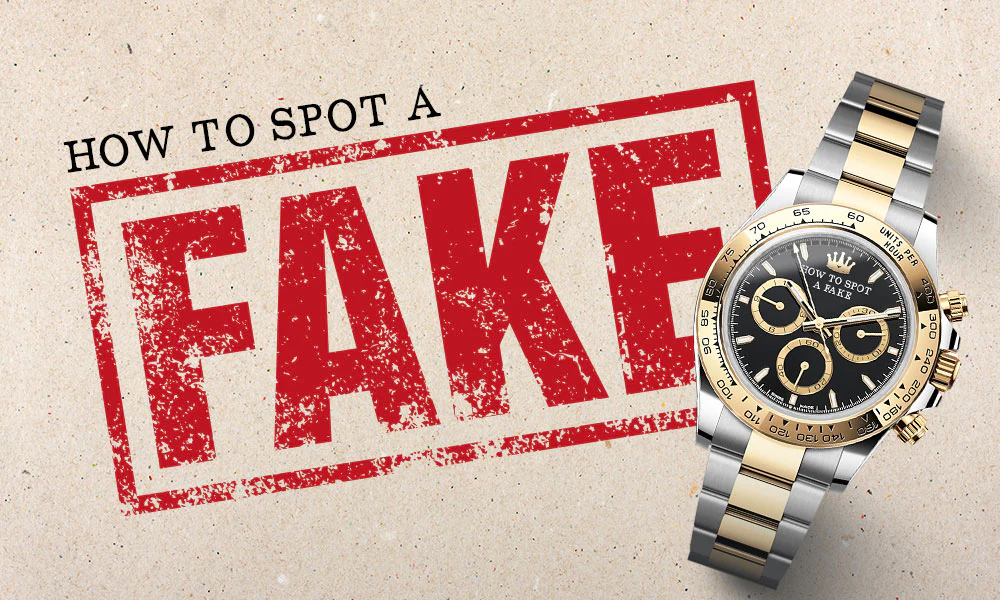Swiss Made watches are globally recognized as a symbol of precision, luxury, and craftsmanship. From Rolex and Omega to Patek Philippe and TAG Heuer, these timepieces represent status and timeless elegance. Unfortunately, their popularity has also made them a target for counterfeiters. Spotting a fake Swiss watch can be tricky, especially as replica manufacturers become increasingly sophisticated.
Whether you’re a first-time buyer or a seasoned collector, this guide will help you identify the signs of a counterfeit Swiss Made watch, build confidence in your purchases, and avoid costly mistakes.
1. Check the “Swiss Made” Mark
The term “Swiss Made” is protected by law and cannot be used freely. For a watch to be legally considered Swiss Made, it must meet strict criteria set by the Swiss government. These include:
-
A Swiss movement
-
Assembly and inspection in Switzerland
-
At least 60% of production costs incurred in Switzerland
Red flag: If the watch says “Swiss Movement” or simply “Swiss,” it’s not necessarily Swiss Made. Be cautious of misspellings like “Swizz Made” or odd font placements. Authentic Swiss Made watches display the label clearly—usually at the 6 o’clock position on the dial.
2. Examine the Craftsmanship
Swiss watches are renowned for their flawless construction. Everything from the weight to the detailing should feel premium.
Key features to inspect:
-
Weight: Genuine Swiss watches are typically heavier due to high-quality metals and complex mechanical parts.
-
Finishing: Look for finely polished or brushed surfaces, clean edges, and no visible glue or uneven seams.
-
Dial: Fonts should be crisp, evenly spaced, and centered. Sub-dials should function, not just appear decorative.
Pro tip: Use a magnifying glass to inspect the dial, hands, and logo. Fakes often reveal imperfections under close scrutiny.
3. Test the Movement
The heart of a Swiss watch lies in its movement. Whether it’s mechanical or quartz, it should be smooth and accurate.
How to check:
-
Second hand sweep: Mechanical Swiss watches usually have a smooth sweeping second hand, not a ticking motion. Quartz models will tick, but with very precise movements.
-
Sound: Hold the watch close to your ear. A loud ticking sound often indicates a cheap movement—Swiss watches run quietly.
If possible, open the case back to inspect the movement. Brands like Rolex, Omega, and Breitling have beautifully engraved, Swiss-marked calibers. A plain or poorly finished movement is a giveaway.
4. Serial Numbers and Reference Codes
Every authentic Swiss watch has a unique serial number engraved—often between the lugs, on the case back, or inside the clasp.
Here’s what to do:
-
Verify the serial number on the brand’s official website or through a trusted dealer.
-
Make sure the reference number matches the exact model, color, and configuration of the watch.
Red flag: Fake watches may have generic or repeated numbers. If the serial looks off or is absent entirely, walk away.
5. Packaging and Documentation
Swiss luxury brands invest in high-quality packaging and paperwork. An authentic Swiss watch will come with:
-
A branded box
-
An instruction manual
-
A warranty card
-
A certificate of authenticity
Compare the packaging and documents with images from the official brand website. Even the smallest errors—misspelled words, faded logos, or incorrect formatting—can signal a fake.
6. Buy from Authorized Dealers
One of the most effective ways to avoid fake Swiss watches is by purchasing from trusted sources.
Safe buying options:
-
Authorized brand retailers
-
Certified pre-owned watch dealers
-
Reputable online platforms (with verified reviews and authentication guarantees)
Be wary of deeply discounted luxury watches from unknown sellers, especially on marketplaces like eBay or Craigslist. If the deal seems too good to be true—it probably is.
7. Get a Professional Appraisal
When in doubt, have the watch inspected by a certified horologist or jeweler. They can verify the authenticity by opening the case, examining the movement, and checking part numbers.
Many Swiss brands also offer authentication services if you contact them directly.
Spotting a fake Swiss Made watch requires a keen eye, knowledge of brand-specific details, and a cautious mindset. Counterfeiters are becoming more sophisticated, but with the right tools and awareness, you can protect yourself and your investment.
Whether you’re shopping for your first luxury timepiece or adding to a growing collection, remember this golden rule: Do your research, trust your instincts, and always buy from reputable sources.
